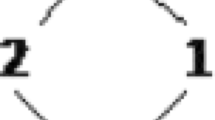Abstract
Following a proposal by Kooi and Tamminga, we introduce a conservative translation manual for every four-valued truth-functional propositional logic into a modal logic. However, the application of this translation does not preserve the intuitive reading of the truth-values for every four-valued logic. In order to solve this problem, we modify the translation manual and prove its conservativity by exploiting the method of generalized truth-values.
Similar content being viewed by others
Notes
The idea of exploiting the method of generalized truth-values firstly appeared in Kubyshkina (2017), but no technical details were provided.
For more details on the distinction between designated truth values for the premises and for the conclusion see Cobreros et al. (2012).
In this sense, LRA is a logic of generalized truth values.
For instance, if one considers that the weakest system that is suitable for knowledge representation should be the system T, with \(K\phi \rightarrow \phi \) as the characteristic axiom, the following property can be imposed on the frames: if \(X \in N_{w}\), then \(w \in X\). It is not difficult to see that this property will not change the structure of the conservativity proof that follows. Moreover, having this property the definition of the translations T1 and F1 can be simplified: T1(p) can be defined as Kp, and F1(p) can be defined as \(K \lnot p\).
\(\mathfrak {X}(\varGamma ) \models _{M}^{w} \mathfrak {Y}(\phi )\) is an abbreviation for ‘if \(M, w \models _{M} \mathfrak {X}(\psi )\) for all \(\psi \in \varGamma \), then \(M, w \models _{M} \mathfrak {Y}(\phi )\)’.
One can keep \(\emptyset \) without altering the proofs that follow. To do so, it suffices to define all the logical operators in a way that they do not distinguish the \(\emptyset \) and \(\{F1\}\) values. For example, if a formula \(\phi \) takes value \(\{F1\}\) and \(\lnot _{4} \phi \) takes value \(\{T1\}\), and if a formula \(\psi \) takes value \(\emptyset \), then \(\lnot \psi \) takes value \(\{T1\}\).
It is not difficult to see, that an order \(x \le y \Leftrightarrow x = x \wedge y\) and a linear lattice of truth-values can be defined for LRA.
The functions \(v^{4}_{1}(\phi ),\ldots ,v^{4}_{n}(\phi )\) are possible \(v^{4}\) valuations of \(\phi \). Keeping in mind the Lemma 6, where each valuation was associated with a 4-w-equivalent world, the use of the subscripts 1, ..., n facilitates notationally the association of the valuations \(v^{4}_{1}(\phi ),\ldots ,v^{4}_{n}(\phi )\) with their 4-w-equivalent worlds \(w_{1}\), ..., \(w_{n}\) respectively.
References
Belnap, N. D. (1977a). How a computer should think. In G. Ryle (Ed.), Contemporary aspects of philosophy (pp. 30–55). Stocksfield: Oriel Press Ltd.
Belnap, N. D. (1977b). A useful four-valued logic. Modern uses of multiple-valued logic, volume 2 of the series Episteme (pp. 5–37).
Cobreros, P., Égré, P., Ripley, D., & van Rooij, R. (2012). Tolerant, classical, strict. Journal of Philosophical Logic, 41, 347–385.
Dunn, J. M. (1976). Intuitive semantics for first-degree entailments and ‘coupled trees’. Philosophical Studies, 29, 149–168.
Kooi, B., & Tamminga, A. (2013). Three-valued logics in modal logic. Studia Logica, 101, 1061–1072.
Kubyshkina, E. (2017). Ignorance without K(nowledge). Logica Yearbook, 2016, 109–123.
Kubyshkina, E., & Zaitsev, D. V. (2016). Rational agency from a truth-functional perspective. Logic and Logical Philosophy, 25, 499–520.
Odintsov, S. P., & Wansing, H. (2015). The logic of generalized truth values and the logic of bilattices. Studia Logica, 103(1), 91–112.
Shramko, Y., Dunn, J. M., & Takenaka, T. (2001). The trilatice of constructive truth values. Journal of Logic and Computation, 11, 761–788.
Shramko, Y., & Wansing, H. (2005). Some useful 16-valued logics: How a computer network should think. Journal of Philosophical Logic, 34(2), 121–153.
Shramko, Y., & Wansing, H. (2006). Hyper-contradictions, generalized truth-values and logics of truth and falsehood. Journal of Logic, Language and Information, 15(4), 403–424.
Shramko, Y., & Wansing, H. (2011). Truth and falsehood. An inquiry into generalized logical values. New York: Springer.
Acknowledgements
I am grateful for helpful comments and suggestions by two anonymous referees of Synthese. Thanks are also due to Paul Egré, Andreas Herzig, Mattia Petrolo, Nicholas J. J. Smith and Allard Tamminga for their feedbacks on previous drafts of some of this material.
Author information
Authors and Affiliations
Corresponding author
Additional information
Publisher's Note
Springer Nature remains neutral with regard to jurisdictional claims in published maps and institutional affiliations.
Rights and permissions
About this article
Cite this article
Kubyshkina, E. Conservative translations of four-valued logics in modal logic. Synthese 198 (Suppl 22), 5555–5571 (2021). https://doi.org/10.1007/s11229-019-02139-3
Received:
Accepted:
Published:
Issue Date:
DOI: https://doi.org/10.1007/s11229-019-02139-3




